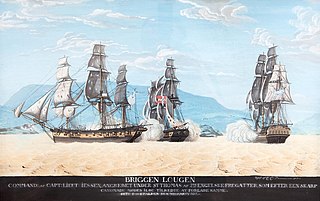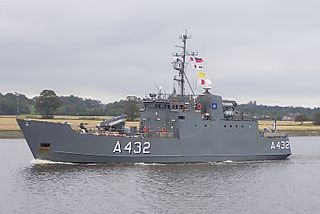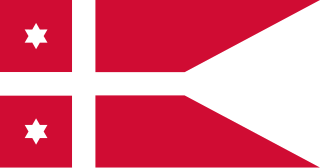
The Royal Danish Navy is the sea-based branch of the Danish Defence force. The RDN is mainly responsible for maritime defence and maintaining the sovereignty of Danish territorial waters. Other tasks include surveillance, search and rescue, icebreaking, oil spill recovery and prevention as well as contributions to international tasks and forces.

During the Napoleonic Wars, the Anglo-Russian War was the phase of hostilities between Great Britain and Russia after the latter signed the Treaty of Tilsit that ended its war with France. Anglo-Russian hostilities were limited primarily to minor naval actions in the Baltic Sea and Barents Sea.

Carl Adolph Rothe was a naval officer in the Royal Danish Navy and governor of the Danish West Indies from 1820 to 1822.

Johan Olfert Fischer was a Danish officer in the Royal Dano-Norwegian Navy. He commanded the Dano-Norwegian fleet against British forces under Lord Nelson during the Danish defeat at Copenhagen on 2 April 1801.

The Danish ironclad Dannebrog was an armored frigate of the Royal Danish Navy that was originally built as an 80-gun ship-of-the-line by Andreas Schifter was launched in 1850 but was reconstructed into a steam-powered ironclad in the early 1860s. She had an uneventful career before the ship was stricken from the navy list in 1875. The ship was converted into an accommodation ship that same year and served until she became a target ship in 1896. Dannebrog was broken up in 1897.

HDMS Lougen was a brig of 18 guns, launched in 1791, and the name-vessel of her class of six brigs designed by the naval architect Ernst Stibolt. She was the first Danish warship to be copper-sheathed. She was active protecting Danish merchant shipping and suppressing pirates in the Mediterranean and in the Caribbean. In March 1801, she fought off the British privateer Experiment and the 22-gun warship HMS Arab in a single action. When the British captured the Danish West Indies in 1801, Lougen was part of the booty. The British later returned her to Denmark where she was broken up in 1802.
HMS Violent was a V-class destroyer of the British Royal Navy that saw service in World War I and was in commission from 1917 to 1937.

HMS Viceroy (D91) was a W-class destroyer of the British Royal Navy that saw service in the final months of World War I and in World War II.

HMS Annan was a River-class frigate built for the Royal Navy but was transferred to the Royal Canadian Navy before commissioning. She served with the Royal Canadian Navy during the Second World War and saw action primarily as a convoy escort in the Battle of the Atlantic. She was returned to United Kingdom following the war and quickly sold to Denmark, who renamed the vessel Niels Ebbesen. She was primarily used as a training vessel until 1963 when she was broken up in Odense. She was named for the River Annan in Scotland in UK and Canadian service and Niels Ebbesen in Danish service.

HMS Monnow was a River-class frigate of the Royal Navy. The frigate served as a convoy escort in the Battle of the Atlantic during the Second World War. Named for the River Monnow in the United Kingdom, the vessel was transferred to the Royal Canadian Navy in 1944, keeping the same name, and finished the war with them. Returned to the Royal Navy following the war, it was sold to the Royal Danish Navy and renamed Holger Danske. It served until 1960 when it was scrapped. The ship is significant as it is one of the few ships employed by the Royal Canadian Navy never to visit Canada.

The Battle of Isefjord was a clash that occurred when the coastal defence ship HDMS Niels Juel was attacked by German forces as she tried to escape to neutral Sweden.

Vice Admiral Helge Hjalmar Immanuel Strömbäck was a Swedish Navy officer. He was the Chief of the Naval Staff from 1942 to 1945 and the Chief of the Navy from 1945 to 1953.
The Royal Danish Navy ranks follows the NATO system of ranks and insignia, as does the rest of the Danish Defence. Outside this ranking system there are physicians, nurses and veterinarians, while priests and judicial personnel wear completely different insignia and are without rank.

Operation Safari was a German military operation during World War II aimed at disarming the Danish military. It led to the scuttling of the Royal Danish Navy and the internment of all Danish soldiers. Danish forces suffered 23–26 dead, around 40–50 injured, and 4,600 captured. Of the roughly 9,000 Germans involved, one was killed and eight wounded, although the number may have been 11 killed and 59 wounded.

The Lindormen class is a class of two minelayers built for the Royal Danish Navy to replace the Lougen-class minelayers that dated from World War II. The Lindormen class was designed to lay controlled controlled minefields in the Baltic Sea during the Cold War as part of NATO's defence plan for the region. They were taken out of service by the Danish in 2004, put up for sale in 2005 and transferred to Estonia in 2006.

The Chief of the Royal Danish Navy is the professional head of the Royal Danish Navy.

British Naval Forces Germany was a command of the Royal Navy that was active from 1944 to 1961 under three titles.

The British Baltic Fleet and also known as the Baltic Squadron was a series of temporary or semi permanent fleets of the Royal Navy. They were assembled at Spithead a naval anchorage in the English Channel for various naval operations in the Baltic Sea from 1658 to 1856 commanded by the Commander-in-Chief, Baltic Fleet.

HDMS Justitia was a Royal Dano-Norwegian Navy ship-of-the-line, built to a design by Henrik Gerner. Although launched in 1777, she was not fully commissioned until 1780. The British Royal Navy seized her in 1807, together with the rest of the Danish fleet after the second battle of Copenhagen. The British never commissioned Justitia. A renaming to Orford in 1809 was cancelled. She was broken up in 1817.

HDMS Justitia was a ship-of-the-line designed by Ole Judichaer built at Nyholm, Copenhagen for the Royal Danish-Norwegian Navy.



















